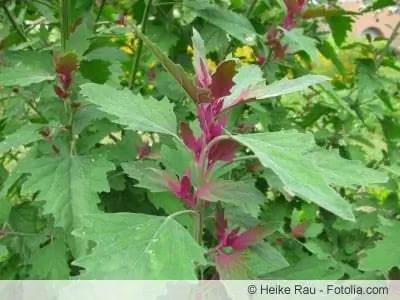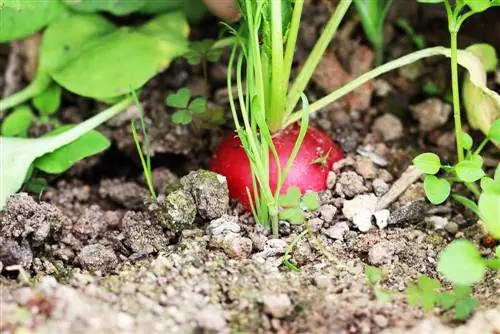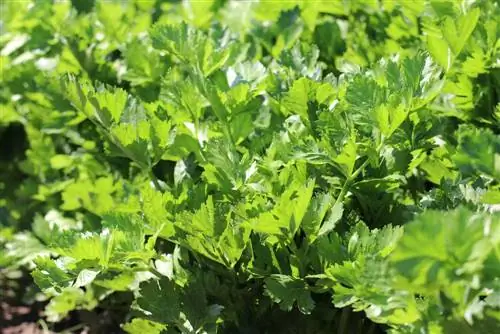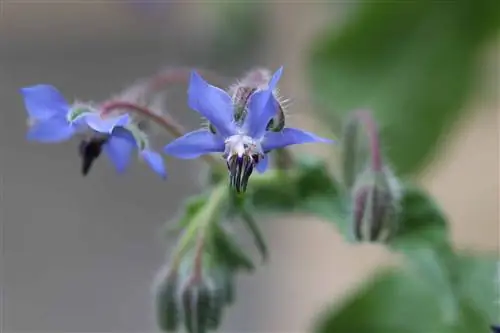- Author admin [email protected].
- Public 2023-12-17 03:39.
- Last modified 2025-01-24 12:45.
The name tree spinach is a little misleading. Although the edible plant grows up to three meters high, it is not actually a tree. In addition, tree spinach is only distantly related to the vegetable spinach (Spinacia) we know. On the other hand, tree spinach can be used in the kitchen just like real spinach. In contrast to real spinach, tree spinach has the advantage that it grows enormously and is therefore very space-saving. This means you can harvest the same plant again and again throughout the summer.
Short profile
- botanical name: Chenopodium giganteum
- other names: giant goosefoot
- sometimes buckwheat is also called tree spinach
- herbaceous annual plant
- Growth height: up to two meters (rarely up to three meters)
- reddish, upright stem
- Leaves: stalked, light green, up to 20 cm long
- Flowering: June to September
- Use: as a vegetable plant (leaves are edible)
- occasionally also as an ornamental plant
Occurrences
The tree spinach (Chenopodium giganteum) originally comes from China and Southeast Asia. Tree spinach has been cultivated in India for a very long time, as the plant easily grows up to three meters in height in tropical wetlands. Nowadays, tree spinach can be found in almost all temperate climate zones and is therefore ideal for cultivation in the garden. However, as a vegetable plant in our gardens, tree spinach is a relatively new phenomenon. The leaves of the tree spinach are edible both cooked and raw, the seeds are also suitable for consumption when cooked.
Location
Given the location conditions, tree spinach is quite uncomplicated. If it has enough light, nutrients and water, it is quite frugal and grows rapidly to over two meters high and around one meter wide within just one growing season. A sheltered location that offers direct sunlight for a few hours a day is best.
- sunny to partially shaded
- sheltered from the wind
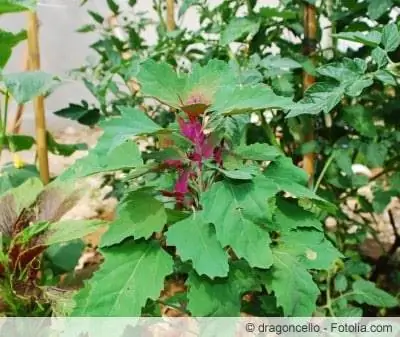
Floor
The tree spinach thrives in almost all soil conditions as long as they are well permeable to water. That's why it can be grown in almost every garden. If the soil is very firm or tends to become waterlogged, some sand should be incorporated. This has two important functions. On the one hand, the water can drain away better, and on the other hand, sand or gravel loosens the soil so that it is better ventilated. Optimal conditions for cultivation are provided by a garden soil that has the following properties:
- medium nutrient content
- well permeable to water
- good air permeability (loose)
Before a Chenopodium giganteum is sown or planted in the garden bed, the soil should be loosened well and a layer of mature compost about two centimeters thick should be incorporated.
Watering and fertilizing
Although tree spinach tolerates drought, the leaves remain softer and more tender if the soil is kept evenly moist. In the event of prolonged drought, the tree spinach must be watered regularly. If a small amount of compost is incorporated into the soil when planting (sowing) Chenopodium giganteum, further fertilization over the course of the year is not necessary. Caution is advised with fertilizers that contain a lot of nitrogen. The giant goosefoot stores nitrogen as nitrate in its leaves.
Care
The tree spinach is a very undemanding plant and does not require any special care. It can be planted as a single specimen or cultivated on an entire bed. The more space the plant has, the better it can thrive and grow in height and width. Chenopodium giganteum produces flowers in June and seeds in late summer. If you want your giant goosefoot to sow itself for the coming year, you can leave the seed heads standing. Otherwise, it is advisable to remove the flowers early, as the tree spinach then puts its energy into the growth of the shoots and leaves.
Sowing outdoors
For annual plants such as tree spinach, it is generally recommended to sow seeds in spring. The seeds can be sown directly outdoors or alternatively pre-cultivated on the windowsill. For a family of four, three plants are usually enough, as long as they are sown as solitary plants at a distance of around 1 to 1.5 meters very early in the year and can therefore reach their maximum height. However, the plants are often sown at shorter intervals and harvested earlier.
- first sowing (outside): from mid-April
- Distance: at least 50 centimeters
- for individual plants: distance 1 to 1.5 meters
- late sowing: possible until June
- Distance: 30-40 centimeters
- Plants sown late don’t grow as big anymore
- First water the garden soil (if the soil is dry)
- Draw a fine line in the soil for better dosage
- Place seeds in the notch at a greater distance
- do not cover with soil (light germinator)
- sprinkle only very thinly with fine sand or alternatively press lightly
- Always keep the soil slightly moist until germination
- leave only the strongest plants standing after germination
- remove all others (note distance)
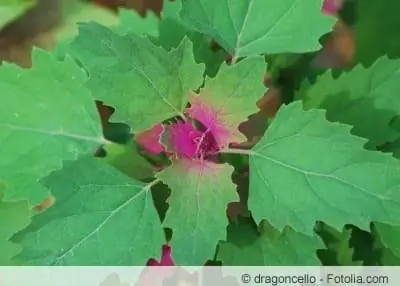
Pre-culture on the windowsill
To give the plants a head start on sowing outdoors, the seeds can also be sown in pots or a mini greenhouse on the windowsill. A cold frame with a glass cover is also ideal for early sowing. However, the tree spinach has to be planted outdoors later because it grows very large very quickly.
- Time: from the beginning of March
- Substrate: potting soil or cactus soil (low nutrient content)
- Slightly moisten the soil before sowing
- Just place the seeds on the soil and press them lightly
- need light to germinate
- Place pots in saucers, pour in about 1 cm of water
- Cover pots with foil or glass pane
- Temperature: over 18 degrees
- Germination time: 2 to 3 weeks
- bright (no direct sun)
- Plant seedlings in individual pots after the second pair of leaves have formed
- Plant outdoors from May
Tip:
A tree spinach is also very easy to cultivate on the balcony as a solitary plant in a pot. However, the pot should have a minimum size of 35 to 40 centimeters so that the plant can develop well.
Harvest
The harvest season begins in June and lasts until autumn. There are two different techniques for harvesting tree spinach, depending on when the tree spinach was sown and how close the plants are to each other.
Pluck individual leaves
If the tree spinach stands alone in the garden and can develop into a huge plant without competition, it is possible to pluck off its leaves at will. When harvesting, the lower leaves should always be removed. The vegetation zone in which the plant forms new leaves must be generously left out. At least 6 to 8 leaves should be retained, otherwise the giant goosefoot cannot continue to grow.
Tip:
If the flower or seed heads are broken out, the tree spinach's broad growth is stimulated. New side shoots continue to form in the armpits until autumn.
Harvest the whole plant
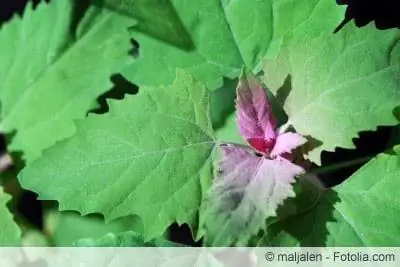
If a bed is created with row spacings of around 30 centimeters, the tree spinach should be harvested completely when it is around 30 centimeters in size, as there will then be no space for it. After the first harvest, re-sowing is possible. In addition, the whole plants are harvested if this is a late sowing in June. The plants are taken out of the ground in autumn well before the first frosts, because in cool temperatures the annual plant wilts and dies.
Tip:
The tree spinach should not be disposed of in the compost. Since there are usually large quantities of ripe seeds on the plant, next year the entire garden might be full of tree spinach.
Conclusion
A tree spinach is a great vegetable alternative for the garden. It is quite undemanding and robust, rarely gets sick and requires almost no care other than occasional watering when it is dry. The plant can be used in the kitchen like real spinach, but is much more space-saving and more productive when harvested. Because the tree spinach grows vertically instead of horizontally and can reach a height of over two meters if sown early and with sufficient distance from neighboring plants. It is harvested between June and September by simply plucking off the lower leaves.

